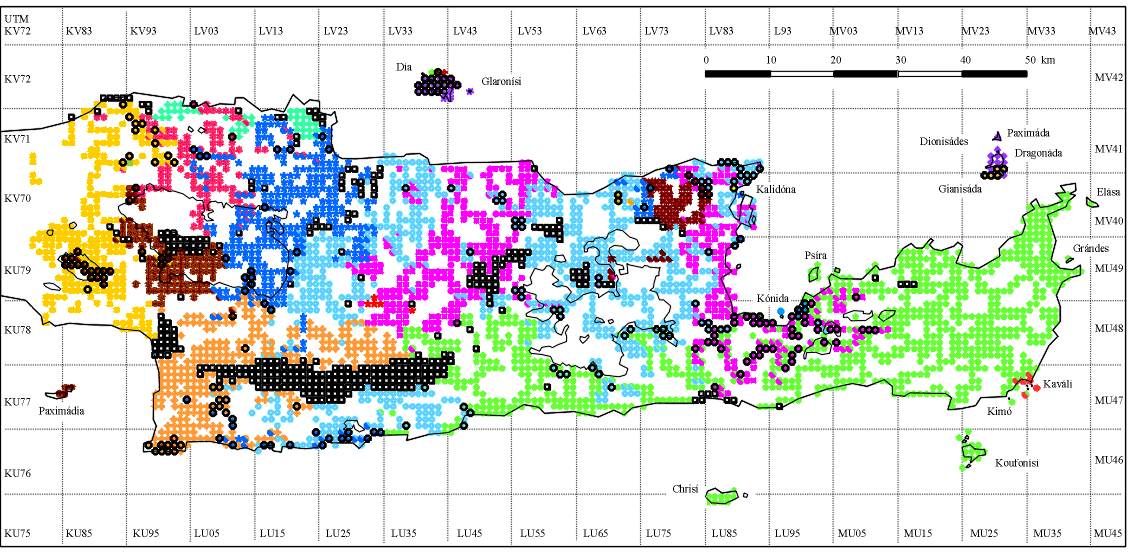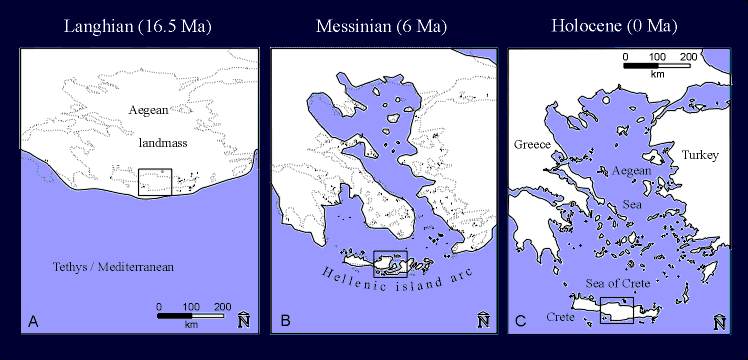
Fig. 1. A group of 120 Albinaria corrugata snails (shell height 2 cm) estivating at the face of a Mesozoic limestone, UTM LU2571 near Kapetanianá, Asteroúsia mountains, 1000 m above sea level, southern central Crete, August 1994.
Albinaria and other Aegean land snails
A research project at the Zoological
Institute of Göttingen
University
(Francisco Welter-Schultes)
Islands and snails
Greece is full of islands, and invertebrate island faunas are always interesting
objects of research. Land snails are slowly moving organisms, and as such they
are potentially good model organisms for studies in biogeography and evolution.
The Mediterranean island of Crete has about 120 land snail species, some
20 of which belong to the clausiliid genus Albinaria. This is
by far the most interesting and easy-to-work-with genus, its species can be
determined by shell characters, and are quite frequent. Working groups in Athens
(Greece) and Leiden (Netherlands) have started to examine the genus molecular
genetically. The studies in Göttingen (Germany) are focussed on a biogeographical,
morphological and geoscientific approach. We all try to understand the phylogenetic
evolution of these snails. This special link between biogeography and phylogenetics
is called phylogeography.
Albinaria land snails: an introduction
Albinaria is a land snail genus from the northern countries of the
eastern Mediterranean, known for its fascinating variety of more than 120 species
and innumerable shell forms. Within the Clausiliidae, a family that comprises
one-fifth of the European land snail species, Albinaria has more species
than any other genus. Speciation, radiation, dispersal and the exciting
geotectonic history of the Aegean plate must have played an important
role in the evolution of the more than 20 species from Crete, an uplifted segment
of the Hellenic island arc.
Albinaria snails feed on microflora of limestones. They are active
only in the winter. In Crete it never rains between May and September.
In the summer season some species can often be seen estivating at the face of
limestone outcrops, the aperture being attached to the substrate. The white
colour of the solid shell reflects the sunlight. Other species seek shelter
from direct sunlight and prefer estivating in crevices. They have a darker and
less solid shell. Albinaria snails reach maturity after two years; most
of them will not live longer than 3 or 4 years.
|
Fig. 1. A group of 120 Albinaria corrugata snails (shell height 2 cm) estivating at the face of a Mesozoic limestone, UTM LU2571 near Kapetanianá, Asteroúsia mountains, 1000 m above sea level, southern central Crete, August 1994. |
Their most considerable predators are 5 mm sized beetles of the genus Drilus,
which attack the estivating snails via the shell (Schilthuizen
et al. 1994, Örstan
1999). Other predators of minor importance are rodents or birds, Poiretia
snails in western Crete, carabids and Eopolita snails (Schilthuizen
et al. 1994).
In the past, Albinaria had a pharmeceutic importance. The Cretan people
knew the snails for providing an efficient remedy against hemorrhages. I met
some very old Cretans who still knew how to apply the remedy.
Albinaria biogeography
The first task to study the biogeography of Albinaria in Crete was the elaboration of an accurate distribution map of the Albinaria species in Crete. This was quite a bunch of field work (430 days...). Here the result. Each dot covers 1x1 km.

|
Literature source if you want to cite this map: Welter-Schultes
1998a |
The next issue is to try to explain these distributional patterns in the light of historical developments. Why are the species distributed the way they are?
Paleogeography of Crete
A prerequisite was to get some information on the dynamic paleogeographic history of Crete in the past 15 million years. 15 M yr ago Crete belonged to a large island or subcontinent that extended from Slovenia to Turkey. At about 10 Ma the sea broke in, large parts of the Aegean were flooded and only the mountain peaks remained in the form of islands. Much later, at 2 Ma, the region of Crete was uplifted tectonically, and much land emerged and the small islands were joined to form present-day Crete, a long single island with about 250 km E-W-extension. With very beautiful beaches...

Fig. 3. Paleogeography of the Aegean in the middle Miocene (A, Langhian) and late Miocene (B, Messinian), and present-day geography (C, Holocene). Central Crete is marked. Literature source if you want to cite this map: Welter-Schultes 2000a (modified after Peters (1985), Kissel & Laj (1988), Rögl (1998), and Ten Veen & Meijer (1998)).
Morphology and colonization
So, for some 8 M yr the snails had lived on the small paleoislands, and then
at 2 Ma they started to invade the newly emerging land between the old
islands. If this theory is correct, then it might be interesting to find out
which paths they took when they invaded the new land. Some background knowledge
is needed to understand the mechanisms of colonization, the relation between
genetic diversity and colonization etc.
In Albinaria it seems to be possible to trace their migration routes
with the morphology of the shells. This involves measuring of some shell parameters
of many many lots of shells collected in Crete, calculating their differences
with a special program, getting highly interesting results, writing it down
and submitting the stuff to the best journals available. Who then reject the
manuscripts because they are too long and the English is too ugly... okay, but
some journals have already accepted some papers.
Correlations with environment
It is highly important to see whether Albinaria shell parameters are or are not correlated with environmental factors. Some Albinaria shell parameters were analysed; shell size, shape, number of whorls, and number of radial teleoconch ribs appear to be useful in our sense. With few exceptioons they do not depend on vegetation types (forests, open areas), on the type of the substrate (pre-Neogene limestones, late Cenozoic limestones, sandy habitats), on the altitude above sea level, and on predation pressure by drilid beetles.
There are some more potential factors that could theoretically have influence, particularly some climate factors (insolation, humidity). They'd need to be analyzed. I personally believe that no environmental factor is correlated with the shells, and that the considerable spatial variation of the shell parameters is subject to some kind of random variation. But this is just a feeling that cannot be cited as a literature reference.
Predation patterns
Albinaria land snails are heavily predated by drilid beetles (Coleoptera: Drilidae). The beetles attack the snail by the shell, leaving a perforation in the shell, so beetle attacks are easily visible in the shell record. What we have, is the proportion of perforated shells from more than 300 localities in Crete (corresponding to those samples where I have more than 10 shells of one site - which means that usually I collected less than 10 specimens), and some small islands off Crete. Based on these data the spatial patterns of predation could be analyzed.
The land snail compositions of at least 65 Aegean islands are known; of these, some 25 islands off Crete were examined by myself. V. Wiese (Cismar, Germany) helped a lot with the determinations of the snails of the small islands off Crete. The island snail faunas were analyzed in light of the theory of island biogeography (species-area relation) (Welter-Schultes & Williams 1999).
Marine archaeologists discovered some land snails on the 3300 yr old sunken Uluburun shipwreck in Turkey, and I tried to determine the species and to see where they came from. They came from Israel(/Palestine), which was a little surprising for the excavation leader who initially would have liked them to come from Syria.
The question whether the tiny 1.5 mm sized vertiginid land snail Truncatellina could be blown away in a heavy storm from one Greek island to another was dealt with in the "flying snails paper" (Kirchner et al. 1997). The results suggest that minute snails could be blown over the sea for several kilometers in heavy storms.
The non-marine molluscs of Albania have been the subject of several papers by Dhimitër Dhora from Shkodra University (Albania) and myself. Among these were a complete atlas of the molluscs of Albania (click here for a list of species derived from this atlas).
Another research project is dealing with the genus Chondrina in Istria (Italy/Slovenia/Croatia), a collaboration with Willy De Mattia from Trieste.
The molluscs of a core section of Lago d'Averno (near Napoli, Italy) were examined by Ira Richling from the University of Kiel (Germany) and myself. The mollusc record from this Holocene crater lake provides a detailed 1600-year record of changes in water quality in response to bradyseismic movements and salinity fluctuations (900 BC to 700 AD). The developments were traced with marine and freshwater molluscs.
Finally I have to admit that I did not do much in the land snail research from 2001 onwards. This is mainly due to other projects getting more time-intensive, such as the project to digitise old zoological literature from our library, but also to the very scarce feedback in the field of malacology and, of course, the complete lack of funds granted to conchological research projects.
Literature list of all papers on Albinaria since 1792
Complete list of papers by F. Welter-Schultes
muell@schrottmails.de hier klicken
Last modified 2.10.2002.
Albinaria hippolyti, central Crete. |
|
|